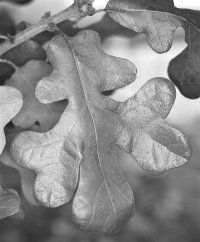| Oak trees have distinct leaves. While there are many kinds of oak trees their leaves are all very similar to each other. |
It’s tempting to buy the fastest growing tree in the nursery, but remember what happened to all those fast growing stocks? Consider an oak for a long-term landscaping investment.
Somehow, faster has become more important than quality to many people, says Jerry Goodspeed, Utah State University Extension horticulturist. However, some of the best trees take patience and time. Though not the fastest growing, oak trees are among the most stately and enduring.
Oaks have many good qualities. Few pests in the Intermountain area affect them. As a hardwood tree, they drop few branches or twigs, even during one of our famous easterly canyon winds. Many oaks have nice fall color, a beautiful shape, and deep green color throughout the summer.
“We have a native oak growing in our foothills and canyons,” Goodspeed says. “Most people recognize it as scrub oak, but its common name is Gamble oak. This oak, usually grown in clumps, reaches between 20 and 30 feet high, and can grow as tall as 50 feet high.”
Gamble oaks are highly drought resistant, he adds. In fact, one of the problems with them becomes apparent when a home is built in their native habitat. Although it has grown in the foothills for hundreds of years without any supplemental water, once we move in, we believe it won’t survive without an extra dose of water a couple times a week. This kills more Gamble oaks than any insect or disease.
One of the largest oaks is the burr (Quercus macrocarpa), Goodspeed says. One of the more hardy oaks, they can reach a height of more than 70 feet, with an equal spread. The burr oak has a moderate growth rate. It can adapt to most growing conditions and soils, and can even thrive in clay soil where water is abundant, or in sandy dry locations with little extra water.
When looking for a columnar tree, consider the beautiful English columnar oak (Quercus robur ‘Fastigiata’), he says. It may grow to 45 feet, but remain columnar-shaped, never getting any wider than about 10 feet. It prefers a well-drained location, but can adapt to many different soil types.
Another popular oak is the northern red oak (Quercus rubra), Goodspeed says. This tree requires more water than the burr or Gamble, has a beautiful shape, and can adapt to most of our soils in Northern Utah. Probably the fasted growing oak in our area, it is a tall tree which reaches a height of more than 50 feet.
This oak also has beautiful fall color in most years, with hues of red, purple and orange covering its branches throughout the autumn season. Because of its fast growth rate, it becomes a handsome shade tree in many landscapes within just a few years time.
The oak with the best sounding name is the swamp white oak (Quercus bicolor), he adds. This is another large oak with a moderate growth rate. One benefit to this oak is its ability to adapt to most soil conditions. Swamp white oak is not very common, so it may take some looking around to find.
“One oak I do not recommend is the pin oak (Quercus palustris), which is commonly sold in our area,” Goodspeed says. “It often struggles with iron chlorosis in many of our heavier soils, but does okay in the bench areas where drainage is excellent. Do not select this tree if your landscape’s soil is heavy clay or your property has a high water table.”

